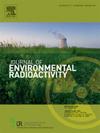Kinetic evaluation for 137Cs desorption from riverine particles in seawater, and exploration of sorbent agents for fixation of the desorbed fraction
IF 1.9
3区 环境科学与生态学
Q3 ENVIRONMENTAL SCIENCES
引用次数: 0
Abstract
In this study, we evaluated 1) the potential ability of sorbents to adsorb 137Cs desorbed from contaminated riverine particles that had been introduced into seawater, and 2) the rates of desorption of 137Cs from weak and strong sorption sites. We performed particle–seawater desorption experiments to simulate the mixing of riverine particles with seawater and used a kinetic model to simulate results. We tested two sorbent agents: beach sand collected from less contaminated coast and zeolite. Neither of the two sorbents sorbed the 137Cs that desorbed from the contaminated river sediment particles because of competition for sorption sites from cations abundant in seawater. Rates of desorption from strong sorption sites, which accounted for 77–99% of the 137Cs carried by the particles, were 3–4 orders of magnitude slower than the rates of desorption from weak sorption sites. The implication was that most 137Cs can be tightly sorbed onto particles. Desorption of 137Cs from weak sorption sites was estimated to be almost complete within 30 min, but 137Cs sorbed onto weak sorption sites was a minor component (1–23% of total 137Cs) of 137Cs on riverine particles.

海水中河流颗粒对137Cs解吸的动力学评价及吸附剂的探索。
在这项研究中,我们评估了1)吸附剂对引入海水的污染河流颗粒解吸137Cs的潜在吸附能力,2)弱和强吸附位点对137Cs的解吸速率。我们进行了颗粒-海水解吸实验来模拟河流颗粒与海水的混合,并使用动力学模型来模拟结果。我们测试了两种吸附剂:从污染较少的海岸收集的沙滩沙和沸石。这两种吸附剂都不能吸收从污染的河流沉积物颗粒中解吸的137Cs,因为海水中丰富的阳离子会竞争吸附位置。强吸附位点的解吸速率比弱吸附位点的解吸速率慢3-4个数量级,占颗粒携带的137Cs的77-99%。这意味着大多数137Cs可以被紧紧吸附在粒子上。137Cs在弱吸附位点的解吸几乎在30分钟内完成,但吸附在弱吸附位点的137Cs只占河流颗粒上137Cs的一小部分(1-23%)。
本文章由计算机程序翻译,如有差异,请以英文原文为准。
求助全文
约1分钟内获得全文
求助全文
来源期刊

Journal of environmental radioactivity
环境科学-环境科学
CiteScore
4.70
自引率
13.00%
发文量
209
审稿时长
73 days
期刊介绍:
The Journal of Environmental Radioactivity provides a coherent international forum for publication of original research or review papers on any aspect of the occurrence of radioactivity in natural systems.
Relevant subject areas range from applications of environmental radionuclides as mechanistic or timescale tracers of natural processes to assessments of the radioecological or radiological effects of ambient radioactivity. Papers deal with naturally occurring nuclides or with those created and released by man through nuclear weapons manufacture and testing, energy production, fuel-cycle technology, etc. Reports on radioactivity in the oceans, sediments, rivers, lakes, groundwaters, soils, atmosphere and all divisions of the biosphere are welcomed, but these should not simply be of a monitoring nature unless the data are particularly innovative.
 求助内容:
求助内容: 应助结果提醒方式:
应助结果提醒方式:


